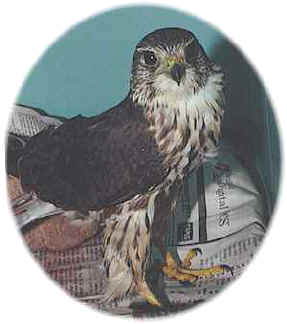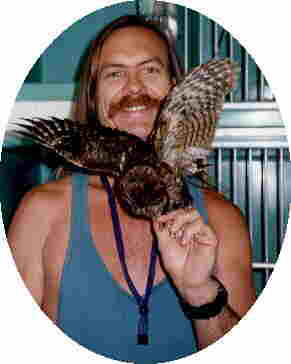 |
 |
"Lots of people talk to animals,
not to many listen - that's the problem" Winnie the Pooh
One of the more interesting patients we have had in our care is a black skimmer. This bird is classified as an "accidental species" because it occurs in North America only by accident according to the Audubon Field Guide to North America.
This particular Black Skimmer suffered a broken right ulna with muscle and nerve damage. The ulna healed very nicely but the muscle damage made her unreleasable. After many calls and with the aid of Marcia Grefsrud of the California fish and Game dept., the skimmer was placed with the Lindsay Wildlife Facility in Walnut Creek.
AWRE would like to extend a big thanks to Marcia for taking her own personal time to place the skimmer with the wonderful Lindsay Wildlife Facility and even transporting the skimmer from Long Beach to Walnut Creek. It's wonderful, caring people such as Marcia that help AWRE fulfill its goals of serving our community.
On 18 Dec 1997, we received a Red Tail
Hawk from the Department of Fish and Game. This bird had been confiscated by them and
brought to us for treatment. The left eye was deflated. Expecting the possibility of a BB
or pellet causing the damage, we did some radiographs. As we suspected, there was a BB
lodged in the eye of this Hawk.
At this point, we felt it time to consult with a specialist, so we contacted an
Ophthalmologist, Dr. Lavach . We hope with his
expertise, we would find out if the Hawks eye could be re-inflated once the BB was
removed. We hoped this would restore the birds sight.
After examining the hawk and reading the
radiographs, he came to the conclusion to leave the BB in place. The eye was sightless but
would heal. No type of surgery could restore sight to this blinded eye. Fortunately,
enucleation, surgical removal of the eye, was not necessary.
It was now up to us to rehabilitate this hawk so it could be released. This turned out to
be a great team effort among the Long Beach Animal Hospital, the Department of Fish and
Game, Jerry Thompson who is another great rehabber with 40 years of experience with
raptors, and AWRE. We treated the hawk’s dietary deficiencies, did lots of lab work
ensuring the health of the animal, and treated the Bumble Foot daily until the Department
of Fish and Game transferred the now healthy, but sightless in one eye, hawk to
Jerry’s facility. It is now up to Jerry to teach this hawk how to hunt with only one
eye. This will probably prove difficult for the hawk. With the loss of an eye he will lose
peripheral vision and depth perception; all very important when you feed yourself and your
family by diving out of the sky and grabbing your next meal. Without Jerry’s skills
and dedication, this hawk and others like him would die of starvation before learning to
adjust to its new disability. Thanks to Jerry and the rest of our team, this hawk will
once again be free to soar the sky.
The moral of this story is: Don't shoot at defenseless animals with bb guns or pellet
guns. More than likely, the animal will have a family it has to take care of and like in
the hawk's case, an injury from careless use of these guns could prove devastating for the
animal and its family.
p.s.
The radiographs also revealed that this Red Tail Hawk had recovered from a broken left
ulna. We did examine the bird to be 100% positive that the wing was completely functional
and it was fine.
Dan
Lavach can be reached at:
EYE CLINIC FOR ANIMALS
13132 Garden Grove Blvd.
Garden Grove, CA
The Merlin is a type of Falcon that is very rarely seen.  Most sightings of a Merlin are made when someone is watching a flock of birds fly
by, and all of a sudden the birds scatter at the same moment a dark streak is seen
splitting the flock. If one were able to follow that streak, you would see a few
feathers trailing behind it. These are telltale indicators that the Merlin has just found
lunch.
Most sightings of a Merlin are made when someone is watching a flock of birds fly
by, and all of a sudden the birds scatter at the same moment a dark streak is seen
splitting the flock. If one were able to follow that streak, you would see a few
feathers trailing behind it. These are telltale indicators that the Merlin has just found
lunch.
When we received this Merlin, it was emaciated and dehydrated; both of which are secondary effects of the broken coricoid (collar) bone. We took a series of radiographs and determined the only chance this Merlin, which we named Merlin, has to return to the wild is to surgically pin the fracture and give it plenty of time to heal.
Dr. Edwardo Acosta, of Sunset Cliffs Animal Clinic in San Diego agreed to do the surgery. We plan to do everything possible to give this beautiful creature the best opportunity to heal and be free; as we do with any animal we treat. Please check here in the future for the rest of this case.
This Burrowing Owl came to us with poisoning symptoms. From his symptoms,  we deduced
this Owl had secondary poisoning from eating a mouse that had eaten poison rodent bait.
Luckily for this Owl, a concerned, caring person found him and brought him straight to us.
We administered an antidote and orally tubed it with a charcoal suspension to absorb and
flush out any poison that might still be undigested. As you can see by its' picture, this
small owl, which in this picture is fully grown, pulled through this ordeal with flying
colors. He was released back where he was found and is fulfilling his natural role in
life. Another happy ending for one of AWRE 's patients.
we deduced
this Owl had secondary poisoning from eating a mouse that had eaten poison rodent bait.
Luckily for this Owl, a concerned, caring person found him and brought him straight to us.
We administered an antidote and orally tubed it with a charcoal suspension to absorb and
flush out any poison that might still be undigested. As you can see by its' picture, this
small owl, which in this picture is fully grown, pulled through this ordeal with flying
colors. He was released back where he was found and is fulfilling his natural role in
life. Another happy ending for one of AWRE 's patients.
This page was last updated:
May 27, 2016
All information is the sole property of All Wildlife Rescue and Education, Inc.
Problems,
questions or comments about the site: Webmaster@awre.org